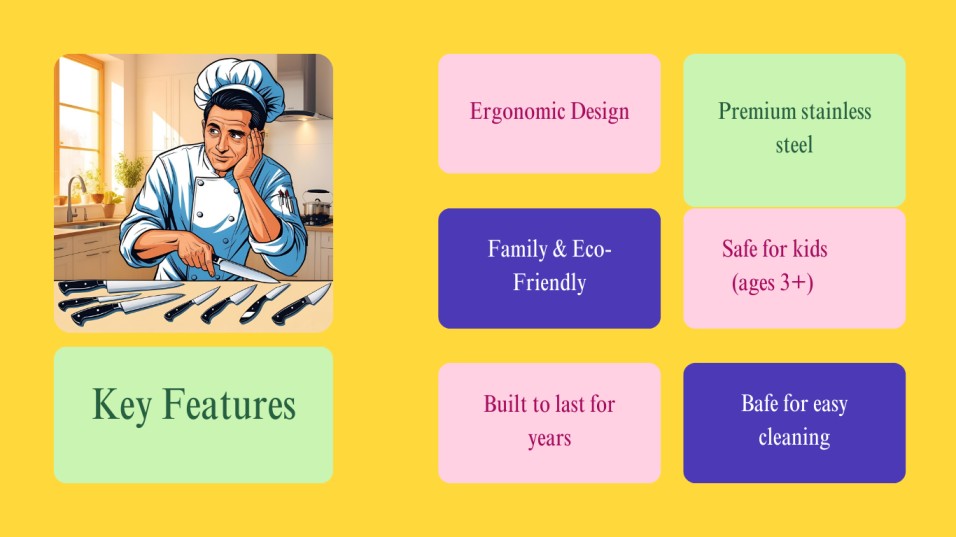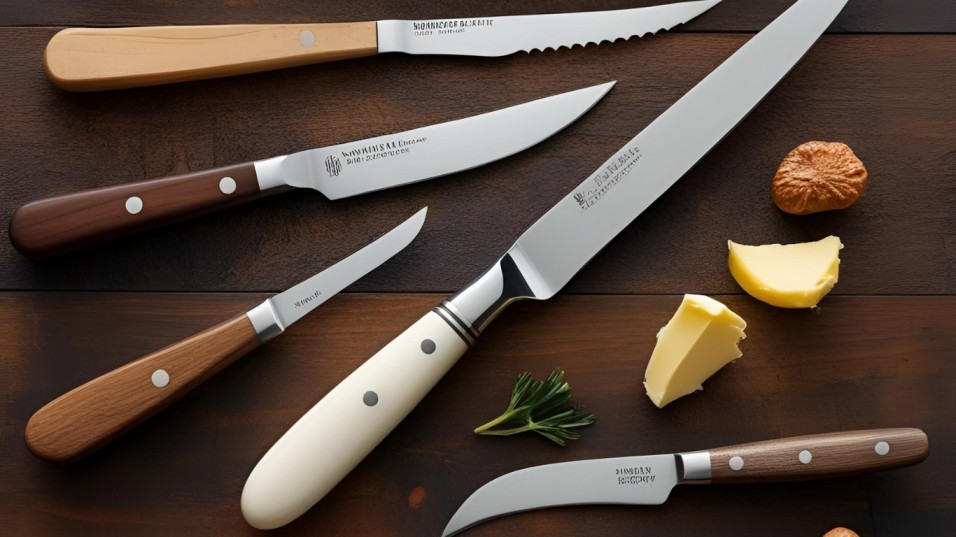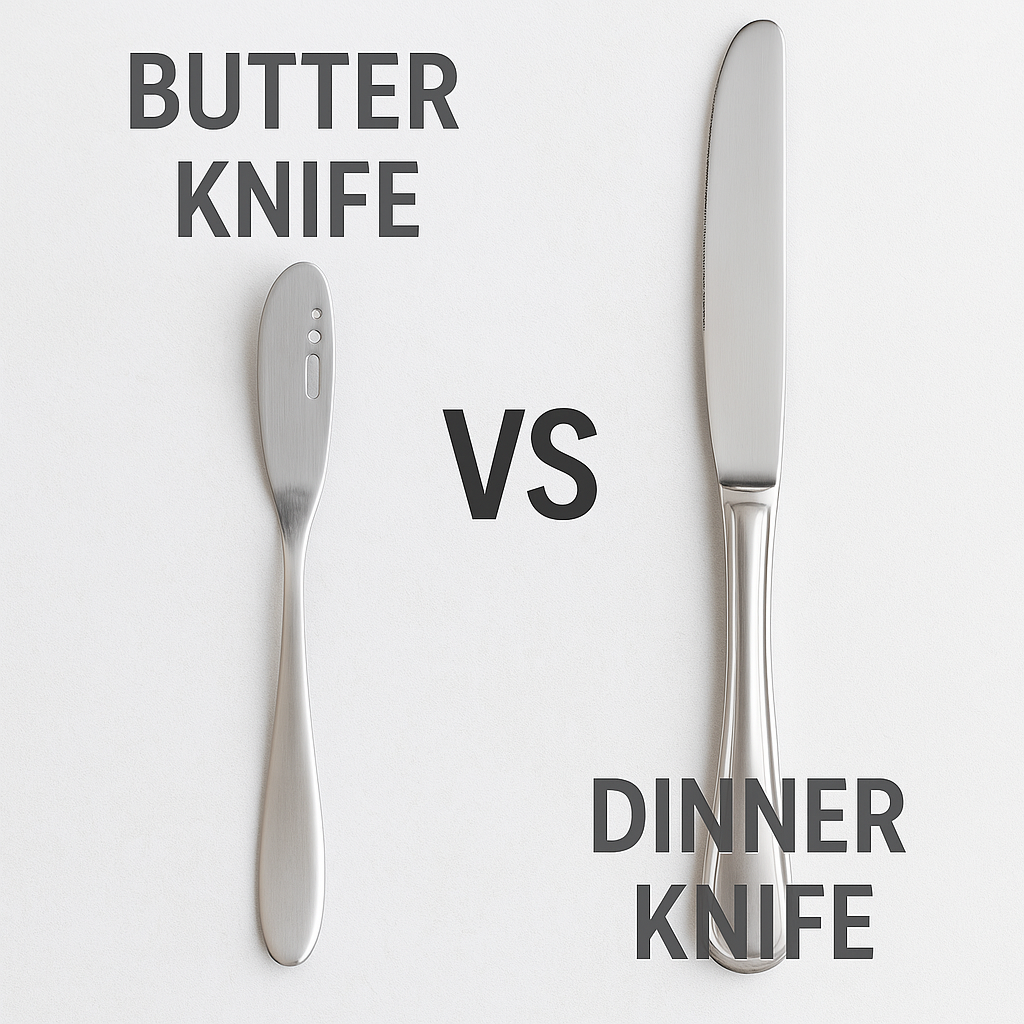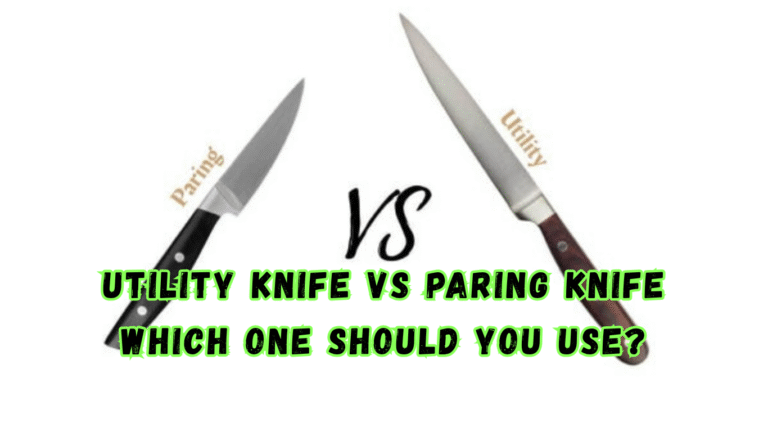Butter Knife vs Dinner Knife: Key Differences You Should Know in 2025
Did you know the first official Butter Knife vs Dinner Knife wasn’t patented until the mid-1800s? Before that, people used whatever was at hand—often their dinner knives or spoons—to spread butter and soft cheeses.
Fast-forward to 2025, and our table settings have evolved into carefully orchestrated arrangements where each utensil has its place and purpose.
This article will explain everything you need to know about Butter Knife vs Dinner Knife: shapes, sizes, materials, etiquette rules, historical context, and practical advice. So whether you’re aiming for the perfect dinner party setting or just tired of smearing butter with the wrong utensil, this guide’s got you covered.
Simple Spreading 3-in-1 Stainless Steel Butter Knife Review (2025)
Why This Isn’t Just Another Butter Knife
You’re not alone if you’ve ever fought with a cold slab of butter and destroyed your toast. Enter the Simple Spreading 3-in-1 Butter Knife – a sleek, stainless steel gadget that curls, cuts, and spreads with surprising precision. It’s not just a kitchen tool; it’s a breakfast game-changer.
Whether you’re a toast enthusiast, charcuterie creator, or a parent with PB&J duties, this gadget handles it all — and does it beautifully.
Key Features

3-in-1 Functionality
- Butter Curler: Slotted blade holes curl cold butter effortlessly.
- Spreader: 1-inch blade width offers generous, even coverage.
- Cutter: Built-in edge slices through cheese, jams, and soft fruits.
Ergonomic Design
- Comfortable grip and weight-balanced for steady hands.
- Safe for kids (ages 3+) with a smooth, non-sharp edge.
Built to Last
- Made from premium stainless steel using German machinery.
- Rust-resistant and dishwasher-safe for easy cleaning.
Family & Eco-Friendly
- Reusable and built to last for years, reducing waste from plastic knives.
- Backed by a lifetime warranty and hassle-free returns.
Butter Knife vs Dinner Knife: Is It Worth It?

I’ve used dozens of butter knives; let me tell you, this one’s a keeper. It feels sturdy in the hand, glides like a pro across toast, and even makes buttering corn a breeze. I especially loved using it on chilled butter during a brunch spread; the curls looked fancy and melted evenly.
Also, shout-out to the safety factor — I handed it to my 5-year-old for peanut butter duty, and no mess, no stress.
For under $11, it outperforms more expensive sets and doubles up as a decent dinner knife.
| Pros | Cons |
| Curler + cutter + spreader in one | Not ideal for slicing hard cheese |
| Kid-safe and ergonomic | Not serrated (no sawing through crusty bread) |
| Dishwasher safe | Curler takes some practice with very cold butter |
| Solid stainless steel build | |
| Great gift or stocking stuffer |
Packaging & Options
- Available as single, double, 4-pack, or 10-pack — great for gifts or restaurant use.
- We ship internationally (yes, even to Bangladesh 🇧🇩).
- Comes with a 10% coupon at checkout.
Final Verdict: Should You Buy It?

If you want a no-nonsense, multipurpose butter knife that makes your breakfast prep smoother, this one’s a steal. It lives up to the hype, ranks #1 in its category, and looks sleek on any table setting.
Highly recommended for:
- Home cooks
- Families with kids
- Brunch lovers
- Host/hostess gifts
A Reliable Cutlery Classic for Everyday Dining
Sometimes, simple is best — and the Amazon Basics 12-piece stainless steel dinner knife set proves just that. Whether you’re stocking up for a family dinner, ordering restaurant service, or just need a solid everyday option that won’t break the bank, this set hits the sweet spot between affordability and quality.
With over 2,300+ positive reviews and Amazon’s Choice status, it’s earned its place at the top of many cutlery drawers.
Butter Knife vs. Dinner Knife: Comparison
| Feature | Simple Spreading 3-in-1 Butter Knife | Stainless Steel Dinner Knives |
| Product Type | Multipurpose Butter Spreader | Standard Dinner Knife |
| Best Use | Spreading butter, cheese, jams, chocolate | General dining (meat, veggies, soft foods) |
| Blade Design | Slotted holes for butter curling, flat edge | Rounded edge, flat blade |
| Material | Stainless Steel (German machinery crafted) | Stainless Steel |
| Set Size | 1 (also available in 2, 4, 10 packs) | 12 knives |
| Length | 6 inches | 10.04 inches |
| Edge Type | Non-serrated with holes for curling | Smooth, non-serrated |
| Ergonomics | Lightweight, kid-friendly design | Balanced, moderate weight |
| Style | Compact, utility-focused | Minimalist, formal look |
| Dishwasher Safe | Yes | Yes |
| Special Features | 3-in-1 (spreader, curler, cutter) | Frustration-Free Packaging |
| Child-Friendly | Yes (ages 3+) | Not explicitly designed for kids |
| Ideal For | Toast, croissants, soft spreads, snacks | Everyday meals, entertaining, formal dining |
| Country of Origin | China | China |
| Warranty | Lifetime warranty + refund guarantee | Amazon Basics standard return policy |
| Price Range | ~$10.89 (Single) | ~$16.37 (Pack of 12) |
| Amazon Rank | #1 in Butter Knives & Picks | #1 in Dinner Knives |
Key Features

Simple Yet Stylish Design
- Polished mirror finish and classic rounded edge that blends effortlessly with existing flatware.
- Great for mixing and matching or building a cohesive table setting.
Substantial Weight, Great Feel
- It is not too light or heavy—just for meal comfort and balance.
- Feels premium in the hand without being flashy or over-designed.
Dishwasher Safe
- Fully dishwasher-safe for everyday use.
- Amazon recommends rinsing within 2 hours of use for the best longevity and shine.
Built to Last
- Constructed from durable stainless steel for rust resistance and long-term use.
- Designed for both home and commercial settings (great for restaurants, cafes, and catering).
What You Get
- 12 stainless steel dinner knives
- Length: 10.04 inches each
- Ships in frustration-free packaging
- Made in China; Amazon brand reliability.
Who It’s For
- Families building or upgrading a dining set
- Restaurants or event planners needing budget-friendly bulk options
- Minimalists seeking a clean, no-frills knife set
- Hosts who want an affordable, uniform set for guests
Pros & Cons
| Pros | Cons |
| Affordable for a set of 12 | No serrated edge (not ideal for cutting steak) |
| Matches most tableware styles | The basic design may be too plain for luxury setups |
| Good weight and balance | No matching spoons/forks included |
| Great for both casual and formal dining |
Final Verdict: Should You Buy It?
If you’re looking for a durable, attractive, and budget-friendly set of dinner knives for daily use or entertaining, this Amazon Basics set is a no-brainer. It’s ideal for anyone looking to equip a kitchen without fuss or overspending.
What Is a Butter Knife?
A butter knife is one of those understated tools that doesn’t draw attention to itself—until you need it. Characterized by its blunt edge and rounded tip, the butter knife is designed to spread rather than cut. Most butter knives are shorter than dinner knives and have a slightly thicker blade to help you scoop and spread without tearing your bread or cracker.
Butter knives are typically found resting horizontally across the bread-and-butter plate, which sits just above the main dinner plate in a formal setting. In casual settings, butter knives may not appear at all—often replaced by teaspoons or even the dinner knife when needed.
The traditional butter knife is not serrated. It’s not built to cut through meat or crusty bread—it’s meant for soft, spreadable foods: think room-temperature butter, cream cheese, jam, soft pâtés, or even frosting.
What Is a Dinner Knife?
The dinner knife is the workhorse of the cutlery world. Longer, sturdier, and sharper than a butter knife, it’s designed for cutting and eating the main course. Most dinner knives have a slightly serrated edge, though some high-end versions have a smooth blade for soft slicing.
Dinner knives usually measure 8 to 10 inches and are placed to the right of the dinner plate, just outside the spoon (if one is included). In formal dining setups, the outermost knife is used if multiple knives are being used (e.g., fish knife, steak knife, etc.).
A well-made dinner knife can easily cut through cooked meats, steamed vegetables, and starches like potatoes. However, they’re not designed for raw or very tough foods—that’s where a steak knife would come in. Dinner knives are often made of polished stainless steel or silverware-grade alloys, built to last through years of daily use.
The dinner knife has evolved with modern tableware trends—many households in 2025 opt for multi-purpose flatware that balances form and function. Even so, the dinner knife remains a vital part of any complete cutlery setup in casual and formal settings.
Butter Knife vs Dinner Knife: Key Differences
So what’s the difference between a butter knife and a dinner knife? Let’s break it down.
Blade Design
Butter knives have a dull, blunt blade perfect for spreading. Dinner knives usually have a slightly serrated or smooth but sharper edge for slicing cooked foods. The butter knife’s blade is wider and rounder, while the dinner knife’s is longer and narrower.
Functionality
A butter knife is a spreader. That’s it. It doesn’t do well with cutting and certainly won’t get you through a steak. On the other hand, the dinner knife is versatile—it can cut most cooked foods and be used as a spreader in a pinch.
Size & Shape:
Butter knives are typically shorter (around 5–7 inches) and lighter. Dinner knives average 8–10 inches and are designed to balance well in the hand while cutting.
Placement in Table Setting:
Butter knives are typically placed horizontally on top of the bread plate. Dinner knives sit vertically to the right of the main plate, often closest to the plate if only one is used.
Context of Use
You’re more likely to use a butter knife in formal settings or when serving multiple spreads. Dinner knives are ubiquitous in everyday meals, casual dining, and formal events.
Understanding these distinctions helps you set a better table and improves the overall dining experience—whether you’re a guest or host.
When and How to Use Each Knife
Etiquette matters—especially in 2025, when social media loves spotlighting beautiful table settings and proper manners. Knowing when and how to use each knife ensures you don’t just eat well—you dine well.
Use the Butter Knife When:
- You’re spreading butter, jam, cream cheese, or pâté
- The butter is served on a separate bread plate.
- Dining at a formal event with a complete place setting
- You’re serving charcuterie boards or hors d’oeuvres
Use the Dinner Knife When:
- Cutting vegetables, pasta, or tender meat
- You don’t have a separate butter knife (in casual meals)
- You’re eating the main course.
- The dish requires precision cutting (but not as tough as for a steak knife)
Etiquette Tips:
- Don’t lick or double-dip your butter knife
- Place it flat on the bread plate when done.
- Use the dinner knife to push food onto your fork (Continental style)
- Keep the dinner knife blade facing inward when placing it down.
Learning the difference between these knives builds lifelong etiquette and coordination skills in family settings, especially with kids. In professional or hosting situations, it shows refinement and attention to detail.
Do You Need Both?
That depends on your lifestyle.
Minimalists might argue that the dinner knife can do everything a butter knife can—with less elegance. And it’s true: people reach for whatever’s available in most casual meals. However, having both knives adds polish and functionality in formal or intentional hosting.
Butter knives shine in:
- Multi-course meals
- Dinner parties and hosting
- Serving spreads at breakfast/brunch
- Cheese boards and entertaining
Dinner knives are essential for:
- Daily meals
- Cutting tasks during any course
- Restaurant and event settings
- Formal etiquette compliance
There will be a growing trend toward hybrid utensils in 2025, but even then, nothing beats a well-defined butter knife when it comes to elegance and ease of spreading. If you love hosting, investing in both types makes your table look thoughtful and your guests feel cared for.
| Category | Tips |
| Cleaning | – Hand-wash butter knives with wood or specialty handles |
| – Stainless steel knives are usually dishwasher-safe | |
| – Avoid acidic detergents that can corrode blades | |
| Storage | – Use cutlery trays to prevent scratching |
| – Store high-end silver in anti-tarnish cloth rolls | |
| – Keep frequently used knives separate from sharp utensils | |
| Maintenance | – Dry knives immediately after washing to prevent water spots |
| – Avoid soaking knives overnight | |
| – Occasionally polish silverware with food-grade, safe polish |
Conclusion
So what’s the final verdict on butter knife vs dinner knife? Both are stars in their own right. The butter knife excels at spreading—cleanly and elegantly—while the dinner knife easily handles slicing, cutting, and assisting your fork.
While some homes may get by with just dinner knives, having both gives you flexibility, etiquette points, and a more refined dining experience. So whether you’re hosting brunch or setting the table for a holiday feast, consider giving each knife its moment to shine.
FAQS
Q1: What is the main difference between a butter knife and a dinner knife?
A: A butter knife is typically smaller, non-serrated, and designed for spreading soft foods like butter, jams, and soft cheeses. A dinner knife is larger, often with a rounded or slightly serrated edge, and is meant for cutting soft foods during meals.
Q2: Can I use a butter knife as a dinner knife?
A: Technically, yes, but it’s not ideal. Butter knives are not designed for cutting; they’re better for spreading. Dinner knives offer more leverage and are suited for slicing through cooked foods.
Q3: Are butter knives safe for children?
A: Yes! Most butter knives, especially those like the Simple Spreading 3-in-1, are safe for children due to their blunt edges and ergonomic design. Always supervise younger kids for safety.
Q4: Should I hand-wash my knives or use the dishwasher?
A: Usually, Stainless steel dinner knives are dishwasher-safe. However, knives with wooden or decorative handles should be hand-washed to avoid damage. Always dry immediately to prevent water spots.
Q5: What makes the Simple Spreading 3-in-1 butter knife special?
A: It combines one tool’s spreading, curling, and cutting functions. It’s ideal for harder butters and soft cheeses and includes ergonomic design features even kids can use safely.
Q6: How many dinner knives should I have in a set?
A: A basic set typically includes 12 dinner knives, like the Amazon Basics pack. This is great for households, hosting, or restaurants to accommodate guests.
Q7: Can I sharpen butter knives or dinner knives?
A: Dinner knives with a straight edge can be lightly sharpened, though many are not designed for sharpening. Butter knives typically do not require sharpening as they aren’t used for cutting tough foods.




